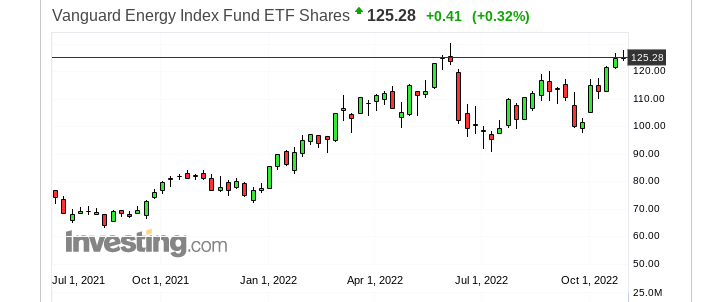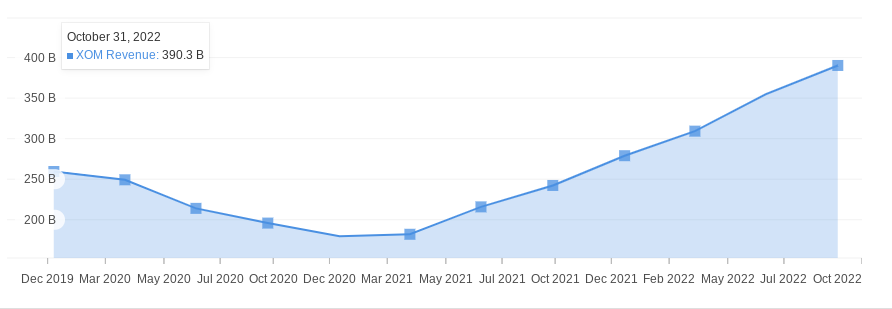- Exxon runs one of the most defensive portfolios within its peer group
- Exxon’s latest earnings report provided strong evidence to back a bull case for its stock
- Another big difference in the latest oil boom is that Exxon isn’t deviating from its spending discipline
It’s a great time to be an investor in energy stocks. After many years of underperformance that lasted until the market crash of 2020, oil and gas producers are firing on all cylinders.
Vanguard Energy Index Fund ETF Shares (NYSE:VDE)—whose top 10 holdings include Exxon Mobil (NYSE:XOM) and Chevron (NYSE:CVX)— has soared 62% this year, adding to 224% gains during the past two years. During that time, the benchmark S&P 500 delivered an 18% return, while the tech-heavy NASDAQ 100 Index is almost flat.
After reaping these spectacular gains, a dilemma that many investors like me are facing is whether this is the right time to take some money off the table. Though it’s impossible to time the market, the rationale behind this thinking is quite clear.

The risk of a prolonged recession is real, given the sticky nature of inflation and the Federal Reserve’s resolve to tame it through its aggressive monetary tightening drive. Oil has shed about a quarter of its value since June amid rising interest rates and the weakening demand from China, where authorities continue to impose strict lockdowns to prevent COVID-19 spread.
While these headwinds are real and could end the party abruptly in oil stocks, I don’t recommend fully closing this trade at this point. And I’m sticking with my position in Exxon, the largest oil and gas producer in the U.S. Its stock, which hit an all-time high today, is up more than 80% this year.
The current dynamics in energy markets favor super-majors like XOM. My reason to hold Exxon is that the company runs one of the most defensive portfolios within its peer group. It has the right mix of assets, with exposure to international gas and liquified natural gas (LNG)—a commodity that is in extremely short supply due to the Russian conflict in Europe. The diversified nature of its business will keep it well-supported even if oil demand weakens.
Highest-Ever Profit
The Texas-based Exxon’s latest earnings report provided strong evidence to back up a bull case for XOM. Even when oil prices dipped in the previous quarter, Exxon was able to post the highest profit in its 152-year history on the strength of natural gas demand. Exxon, according to a Bloomberg report, is forecast to post full-year profit in excess of $50 billion – more than Amazon.com (NASDAQ:AMZN), Procter & Gamble (NYSE:PG) and Tesla (NASDAQ:TSLA) combined.

Source: InvestingPro
Another big difference that will sustain this post-pandemic rally is that the company isn’t deviating from its spending discipline. That’s a major shift from the past booms when the energy producer went on to massively increase its development budget, leaving less money to return to shareholders.
Exxon in its recent guidance told investors that it has locked long-term spending at about $22.5 billion a year – 30% below pre-COVID levels – with production growth from Guyana and the Permian Basin largely offsetting asset sales and natural field declines elsewhere. The spending discipline and the cost cuts made during the pandemic will help the producer to achieve a lower break-even cost of about $30-a-barrel by 2027, down from $41 in 2021.
Highlighting this strength, Jefferies said in a note to clients that Exxon is situated to outperform peers in the next five years given its strong financial position.
“XOM is ‘on the front foot’ and we see attractive risk/reward, particularly for generalists needing energy exposure,” the note said, citing opportunities in both its upstream and downstream businesses.
The note further adds:
“Cash flow growth guidance achievable driven by cost reduction and portfolio high-grading, even in the backwardated commodity environment and lower than consensus downstream earnings.”
Another reason to remain bullish on XOM's prospects is the company's solid dividend and share buyback program, which offers a great incentive for long-term investors to hold this name in their portfolios. Exxon now pays $0.91 a share quarterly dividend, which translates into a 3.29% annual dividend yield.
Exxon paid more in dividends over the last 12 months than Apple (NASDAQ:AAPL) did to become the second-largest in the S&P 500 Index. In addition to payouts, Exxon is also spending $15 billion this year to buy back its shares, one of the largest among bluechip companies.
Bottom Line
It’s perhaps a good time to trim some of your energy holdings after reaping massive benefits during the past two years. But for long-term investors, keeping some exposure to this crucial segment of the market isn’t a bad idea. XOM stock is my favorite in this group due to the company’s defensive nature and its preference to return cash to existing shareholders.
Disclaimer: At the time of writing, the author is long on Exxon stock. The views expressed in this article are solely the author’s opinion and should not be taken as investment advice.
